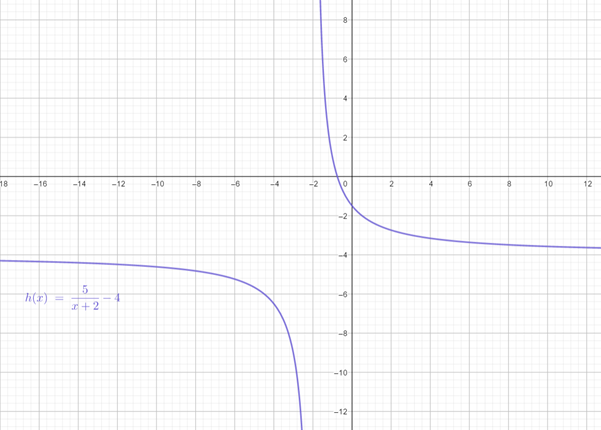
a.
To identify : the parent function.
a.
Answer to Problem 106RE
The parent function is
Explanation of Solution
Given information :
The function is
form the function provided in the question it can be observed that the function is transformed by the parent function of
b.
To describe : the sequence of transformations
b.
Answer to Problem 106RE
shift the graph 2 unit left then stretch the graph vertically by a factor of
Explanation of Solution
Given information :
The function is
since parent function is
c.
To draw : the graph of function h.
c.
Explanation of Solution
Given information :
The function is
graph : first, to graph the parent function use the point plotting,
| x | 1 | -2 | -3 | -4 |
| y | 1 |
Now, shift the graph 2 unit left then stretch the graph vertically by a factor of
Thus, the graph can be obtained as:

Interpretation: from the above graph it can be observed thatto graph
d.
To find : the function h in the terms of function of f.
d.
Answer to Problem 106RE
the function h in the terms of function of f is
Explanation of Solution
Given information :
The function is
Calculation : since
Hence, the function h in the terms of function of fis
Chapter 1 Solutions
Precalculus with Limits: A Graphing Approach
- Two cables tied together at C are loaded as shown. Given: Q = 130 lb. 8 30° C B Q 3 4 Draw the free-body diagram needed to determine the range of values of P for which both cables remain taut.arrow_forwardCable AB is 103 ft long and the tension in the cable is 3900 lb. 56 ft A 50° 20° B x C Identify the angles 0.0, and 8, that define the direction of force. 1 By N 2 Match each of the options above to the items below. 142.1° 57.1° 73.3° 3 8.arrow_forwardIn the given figure, P = 51 lb . 65° C 25° 35° 75 lb P Determine the corresponding magnitude of the resultant. The corresponding magnitude of the resultant is| lb.arrow_forward
- Cable AB is 103 ft long and the tension in the cable is 3900 lb. 56 ft D y A B 20° 50° x C Identify the x, y, and z components of the force exerted by the cable on the anchor B. 1 F. FI 3 Fy 2 Match each of the options above to the items below. 2,120 lb 1,120 lb -3,076 lbarrow_forwardIn the given figure, P = 51 lb. 65° 25° 35° 75 lb P B Determine the required tension in cable AC, knowing that the resultant of the three forces exerted at point C of boom BC must be directed along BC. The required tension in cable AC is lb.arrow_forwardhelp on this question about Laplace transformation?arrow_forward
- Help me expand this fraction below.arrow_forwarddetermine the final and initial value of the expression below: Helparrow_forwardThe boom OA carries a load P and is supported by two cables as shown. Knowing that the tension in cable AB is 190 lb and that the resultant of the load P and of the forces exerted at A by the two cables must be directed along OA, determine the tension in cable AC. 29 in. B 24 in. 36 in. C 25 in. 48 in.. Aarrow_forward
- Find the distance (d) from the point (8, -7, -1) to the plane 3x+5y-3z = -60.arrow_forwardThe 60-lb collar A can slide on a frictionless vertical rod and is connected as shown to a 65-lb counterweight C. Draw the free-body diagram of the collar that is needed to determine the value of h for which the system is in equilibrium. -15 in. A 60 lb B C h 65 lbarrow_forwardTwo cables tied together at Care loaded as shown. Given: Q = 130 lb. 30° C B Determine the range of values of P for which both cables remain taut. lbarrow_forwardarrow_back_iosSEE MORE QUESTIONSarrow_forward_ios
 Calculus: Early TranscendentalsCalculusISBN:9781285741550Author:James StewartPublisher:Cengage Learning
Calculus: Early TranscendentalsCalculusISBN:9781285741550Author:James StewartPublisher:Cengage Learning Thomas' Calculus (14th Edition)CalculusISBN:9780134438986Author:Joel R. Hass, Christopher E. Heil, Maurice D. WeirPublisher:PEARSON
Thomas' Calculus (14th Edition)CalculusISBN:9780134438986Author:Joel R. Hass, Christopher E. Heil, Maurice D. WeirPublisher:PEARSON Calculus: Early Transcendentals (3rd Edition)CalculusISBN:9780134763644Author:William L. Briggs, Lyle Cochran, Bernard Gillett, Eric SchulzPublisher:PEARSON
Calculus: Early Transcendentals (3rd Edition)CalculusISBN:9780134763644Author:William L. Briggs, Lyle Cochran, Bernard Gillett, Eric SchulzPublisher:PEARSON Calculus: Early TranscendentalsCalculusISBN:9781319050740Author:Jon Rogawski, Colin Adams, Robert FranzosaPublisher:W. H. Freeman
Calculus: Early TranscendentalsCalculusISBN:9781319050740Author:Jon Rogawski, Colin Adams, Robert FranzosaPublisher:W. H. Freeman
 Calculus: Early Transcendental FunctionsCalculusISBN:9781337552516Author:Ron Larson, Bruce H. EdwardsPublisher:Cengage Learning
Calculus: Early Transcendental FunctionsCalculusISBN:9781337552516Author:Ron Larson, Bruce H. EdwardsPublisher:Cengage Learning





